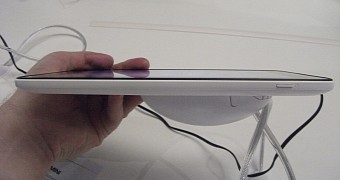Microsoft has reportedly built a new Windows 8.1 version for partners in order to accommodate more devices and thus support the company’s efforts to bring more affordable devices to the market.
The first such device to get the new Windows 8.1 is Toshiba’s Encore Mini tablet, which comes with a resolution of 1024x600 px, below the minimum one required by Windows 8.1: 1024x768 px.
While this is indeed just a slight change, it appears that Microsoft was planning it since earlier this year, as the updates that it applied to the operating system make it suitable for smaller and cheaper devices as well.
According to Microsoft itself, Windows 8.1 was expected to spawn a new wave of affordable devices, and although their launch was delayed for a few months, they’re now here with a number of changes serving as living proof that Redmond worked together with partners to tweak the operating system.
This is the Toshiba Encore Mini
Toshiba’s Windows 8.1 device comes with 1 GB of RAM and 16 GB of storage space, enough to run Microsoft’s operating system and cope with it pretty fine.
Of course, do not expect the tablet to be able to run very advanced games or applications, but it does handle the operating system smoothly and doesn’t seem to be slowed down when performing a number of tasks requiring more CPU power.
According to a report by TechRadar, Peter Han, VP worldwide marketing for Microsoft, said that Redmond engineers collaborated with Toshiba experts to make all apps compatible for this new resolution, thus trying to offer the same experience as on larger devices.
The company most likely did the same thing with other companies as well, some of which could launch their devices in the coming months, but Microsoft prefers to remain tight-lipped on this right now.
Windows 8.1 system requirements
Back in October 2013, when Microsoft officially introduced the new Windows 8.1, the company announced with much fanfare that the first Windows 8 update would also make some changes in terms of system requirements, thus allowing more devices to run it.
The company indeed lowered the minimum required RAM to 1 GB and tweaked the operating system to be used better in portrait mode, so smaller tablets, including those featuring a 7-inch display, should have no issue running it if the hardware is powerful enough to handle the operating system.
Here are the official Windows 8.1 system requirements, as provided by Microsoft:
Processor: 1 gigahertz (GHz) or faster with support for PAE, NX, and SSE2 (more info) RAM: 1 gigabyte (GB) (32-bit) or 2 GB (64-bit) Hard disk space: 16 GB (32-bit) or 20 GB (64-bit) Graphics card: Microsoft DirectX 9 graphics device with WDDM driver

 14 DAY TRIAL //
14 DAY TRIAL //